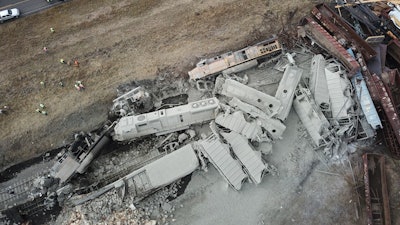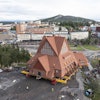
On Monday, the National Transportation Safety Board determined that an airbrake failure caused the fatal collision between two Union Pacific trains in Granite Canyon, Wyoming.
On Oct. 4, 2018, the collision occurred when the air brakes on an eastbound UP freight train failed while descending a hill.
According to the NTSB, an air flow restriction in the brake pipe caused the air brake system to fail, and the end-of-train device failed to respond to an emergency brake command.
 Kinked end-of-railcar air hose on train involved in the November 23, 2018, incident west of Cheyenne, Wyoming.UP via NTSB
Kinked end-of-railcar air hose on train involved in the November 23, 2018, incident west of Cheyenne, Wyoming.UP via NTSB
The striking train collided with the rear of a standing UP freight train at about 55 mph, causing the lead locomotives of the striking train and railcars of both trains to derail.
The locomotive engineer and conductor of the striking train were killed.
The investigation revealed the locomotive engineer applied the emergency brake as the train descended, however, the train’s speed continued to increase. After the emergency brake application, the crew received a “front-to-rear no communication” message indicating the emergency brake request was not received at the end-of-train device, which would have initiated an emergency brake application from the rear of the train.
 Kinked intermediate end-of-railcar air hose that was discovered during an inspection after an end-of-railcar air hose arrangement was incorrectly applied.UP via NTSB
Kinked intermediate end-of-railcar air hose that was discovered during an inspection after an end-of-railcar air hose arrangement was incorrectly applied.UP via NTSB
In its final report issued Monday, the NTSB noted UP’s failure to maintain its railcars, including regularly performing single railcar air brake tests as required by federal regulations, contributed to the collision.
“Had Union Pacific followed the rules and conducted air brake tests, any defects would likely have been identified and this accident could have been prevented,” said Robert Hall, NTSB Director of the Office of Railroad, Pipeline and Hazardous Materials Investigations. “This accident is an example of the industry not complying with federal regulations that are already in place to ensure transportation safety.”
 Wheel set from the striking train. The blue discoloration indicates overheating.NTSB
Wheel set from the striking train. The blue discoloration indicates overheating.NTSB
Regulatory communication protocols in place at the time of the collision, allowed for an extended lapse in communication between the head-of-train device and the end-of-train device without warning the train crew of the loss communication. The NTSB determined these protocols also contributed to the collision.
The NTSB issued a total of four safety recommendations to the Federal Railroad Administration, Association of American Railroads and the American Short Line and Regional Railroad Association, based on the findings of its investigation.
The safety recommendations address safety issues including railcar maintenance, inspection, and testing, limitations of emergency brake command to end-of-train device, head-of-train and end-of-train communication loss duration and grade locations on railroad lines with communication loss.
 Striking train’s wheel set. Composite material is worn off the brake shoe.NTSB
Striking train’s wheel set. Composite material is worn off the brake shoe.NTSB






















